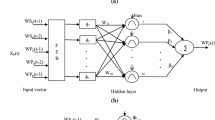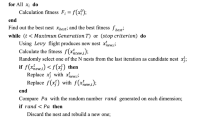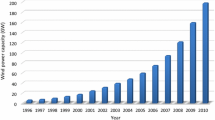Abstract
Forecasting of wind speed plays an important role in wind power prediction for management of wind energy. Due to intermittent nature of wind, accurately forecasting of wind speed has been a long standing research challenge. Artificial neural networks (ANNs) is one of promising approaches to predict wind speed. However, since the results of ANN-based models are strongly dependent on the initial weights and thresholds values which are usually randomly generated, the stability of forecasting results is not always satisfactory. This paper presents a new hybrid model for short term forecasting of wind speed with high accuracy and strong stability by optimizing the parameters in a generalized regression neural network (GRNN) using a multi-objective firefly algorithm (MOFA). To evaluate the effectiveness of this hybrid algorithm, we apply it for short-term forecasting of wind speed from four wind power stations in Penglai, China, along with four typical ANN-based models, which are back propagation neural network (BPNN), radical basis function neural network (RBFNN), wavelet neural network (WNN) and GRNN. The comparison results clearly show that this hybrid model can significantly reduce the impact of randomness of initialization on the forecasting results and achieve good accuracy and stability.
Access this chapter
Tax calculation will be finalised at checkout
Purchases are for personal use only
Similar content being viewed by others
References
Alboyaci, B., Dursun, B.: Electricity restructuring in Turkey and the share of wind energy production. Renew. Energy 33(11), 2499–2505 (2008)
Cordeiro, M., Valente, A., Leitão, S.: Wind energy potential of the region of Trásos-Montes and Alto Douro Portugal. Renew. Energy 19(1–2), 185–191 (2000)
Liu, H., Tian, H., Chen, C., Li, Y.: A hybrid statistical method to predict wind speed and wind power. Renew. Energy 35(8), 1857–1861 (2010)
Abdel-Aal, R., Elhadidy, M., Shaahid, S.: Modeling and forecasting the mean hourly wind speed time series using GMDH-based abductive networks. Renew. Energy 34(7), 1686–1699 (2009)
Lei, M., Shiyan, L., Chuanwen, J., Hongling, L., Yan, Z.: A review on the forecasting of wind speed and generated power. Renew. Sustain. Energy Rev. 13(4), 915–920 (2009)
Flores, P., Tapia, A., Tapia, G.: Application of a control algorithm for wind speed prediction and active power generation. Renew. Energy 30(4), 523–536 (2005)
Sfetsos, A.: A comparison of various forecasting techniques applied to mean hourly wind speed time series. Renew. Energy 21(1), 23–35 (2000)
Mohandes, M., Halawani, T., Rehman, S., Hussain, A.: Support vector machines for wind speed prediction. Renew. Energy 29, 939–947 (2004)
Chen, N., Qian, Z., Meng, X.: Multistep wind speed forecasting based on wavelet and gaussian processes. Math. Probl. Eng. (2013)
Yang, X.: Multi-objective firefly algorithm for continuous optimization. Eng. Comput. 29, 175–184 (2013)
Shu, T., Gao, X., Chen, S., Wang, S., Lai, K., Gan, L.: Weighing efficiency-robustness in supply chain disruption by multi-objective firefly algorithm. Sustainability 8, 250–277 (2016)
Author information
Authors and Affiliations
Corresponding author
Editor information
Editors and Affiliations
Rights and permissions
Copyright information
© 2017 Springer International Publishing AG
About this paper
Cite this paper
Lu, H., Heng, J., Wang, C. (2017). An AI-Based Hybrid Forecasting Model for Wind Speed Forecasting. In: Liu, D., Xie, S., Li, Y., Zhao, D., El-Alfy, ES. (eds) Neural Information Processing. ICONIP 2017. Lecture Notes in Computer Science(), vol 10637. Springer, Cham. https://doi.org/10.1007/978-3-319-70093-9_23
Download citation
DOI: https://doi.org/10.1007/978-3-319-70093-9_23
Published:
Publisher Name: Springer, Cham
Print ISBN: 978-3-319-70092-2
Online ISBN: 978-3-319-70093-9
eBook Packages: Computer ScienceComputer Science (R0)




